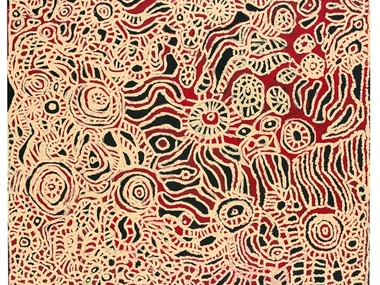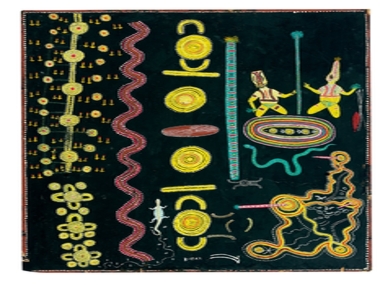THE DESERT COMES TO ADELAIDE

Kapi Tjukula 2009 by Dickie MINYINTIRI Pitjantjatjara people, Synthetic polymer paint on linen 131.5 x 153.5 x 3.0 cm d'Auvergne Boxall Bequest Fund 2009 Art Gallery of South Australia, Adelaide © Dicki Minyintiri, Courtesy of Ernabella Arts Kapi Tjuku
Posted by Jeremy Eccles | 24.11.10
Gallery: Art Gallery of South Australia
Dates:
29.10.10
: 26.01.11
The Art Gallery of SA has organised its second big exhibition of Aboriginal art from the Desert, showing until the end of January and accompanied by a big catalogue. It's a very generous and gentle introduction to the art that first emerged in 1971 in Papunya and is still pouring out of communities like Utopia, Balgo, Hermannsburg and Kintore, not to mention the Spinifex and APY Lands that have joined the charge so enthusiastically in more recent years.
Both of the latter get a good showing in the AGSA catalogue, Desert Country. Missing, though is Yuendemu for no reason that's explained; and the push by Desert artists up the Canning Stock Route into The Kimberley that's so clearly evidenced at the National Museum's current exhibition is also ignored apart from the appearance of Rover Thomas – who, many would argue, put the Desert behind when he invented the East Kimberley painting style with his uncle Jaminji. Jimmy Pike and David Jarinyanu Downs also appear, but are incorrectly associated with Balgo. So, some strange decision-taking by the newly appointed (and first) indigenous curator in Adelaide, the photographer, Nici Cumpston.
And that's also strange. Why would the Gallery have resisted the appointment of a specialist curator for so long? For the AGSA has pioneered so much in Aboriginal art. They were the first public art gallery in Australia – as distinct from museum – to buy a Papunya board. Clifford Possum's classic, lustful Man's Love Story from 1978 was bought by Ron Radford (now running the show in Canberra) in 1980 with the heroic intention of hanging it simply “as an excellent work of art by a living Australian painter”. Indeed, Radford's 1983 Recent Australian Paintings survey includes Possum, Namarari, Dinny Nolan et al comfortably beside Brack, Davila and Davida Allen.
And Radford went on to take his philosophy national with the Bicentennial's Creating Australia exhibition – surprising many in 1988 that such well-known Anglo-Aussie icons as Nolan's Death of Constable Scanlon, Fred McCubbin's Lost and Tom Roberts' Shearing the Rams should appear beside Mawalan Marika's Wawelag Sisters, Turkey Tolson's Women's Dreaming and – once again - Clifford Possum's Man's Love Story. This in particular was lifted above the commonality with a long catalogue essay by Tim Johnson; who made sure that “the viewer is taken into the picture by knowledge of the culture it depicts” by repeating all the information on topography, the events portrayed and the tribal lore being laid down that the SA Gallery received with the canvas from Papunya Tula's John Kean.
Nici Cumpston has presumably had the same sources available, and it's good to find such stories as the Seven Sisters and Wati Kutjarra (Two Men) shared with readers – and, I hope, viewers at the exhibition. There's a wonderful sense of Aboriginal geography, too as Nayankulya Watson from the APY Lands rattles off a list of 14 unmapped names surrounding the waterhole where she was born, all of which appear in her chosen painting. What's odd is that this information is credited to the commercial gallery where the 2008 work was bought rather than Watson's art centre at Ninuku. This is also a problem with some artist's CVs – crediting shows at one gallery that has supplied the information and not mentioning others.
There are some great (and some less-then great) canvases in the 53 artist selection which Jane Hylton, the SA Gallery Director sums up in her Forward as “energised beauty”, a particularly apposite description. Apart from an emphasis on the Spinifex people and APY art – both justifiably SA specialities – the most impressive section is Papunya Tula where the line from Kaapa Mbitjana's green snake, ceremonial pole and painted-up dancer filled 1971 board, Untitled, through Mick Namarari's pure dotting and Uta Uta Tjangala's mosaic work, Ronnie Tjampitjinpa's op art, to Turkey Tolson's pure line austerity is clearly developed. But then there's the pioneering intrusion of Daisy Leura's 1982 painting – she was the great Tim Leura's wife, and it was the first Aboriginal woman's artwork bought by a public gallery – pointing the way to the female stars of today.
The book's a joy to behold. But don't let that stop you visiting the show in Adelaide before 26th January. For you get the chance there to win a splendid Tjungkara Ken painting valued at $4000 – courtesy of Tjala Arts, Marshall Arts in Adelaide and the sponsors Santos.
Share this:
»  del.icio.us
»
del.icio.us
»  Digg it
»
Digg it
»  reddit
»
reddit
»  Google
»
Google
»  StumbleUpon
»
StumbleUpon
»  Technorati
»
Technorati
»  Facebook
Facebook
Contact Details
Gallery: Art Gallery of South Australia
Contact: Nick Mitzevich
Email: agsa.info@artgallery.sa.gov.au
Telephone: +61 8 8207 7000
Address: North Terrace Adelaide Adelaide 5000 SA
Gallery: Art Gallery of South Australia
Contact: Nick Mitzevich
Email: agsa.info@artgallery.sa.gov.au
Telephone: +61 8 8207 7000
Address: North Terrace Adelaide Adelaide 5000 SA

(Untitled) 1971 by Kaapa Mbitjana TJAMPITJINPA Anmatyerre/Arrernte people, Synthetic polymer paint on plywood 124 x 102 x 5.5 cm © Estate of Kaapa Mbitjana Tjampitjinpa, Licensed by Aboriginal Artists Agency, 2010
Where is the exhibition?
Further Research
Gallery: Art Gallery of South Australia
Artists: Clifford Possum | Daisy Leura | David Jarinyanu Downs | Davida Allen | Dinny Nolan | Fred McCubbin | Jimmy Pike | John Brack | Juan Davila | Kaapa Mbitjana | Mawalan Marika | Mick Namarari | Mick Namarari | Nayankulya Watson | Nici Cumpston | Paddy Jaminji | Ronnie Tjampitjinpa | Rover Thomas | Sidney Nolan | Tjungkara Ken | Tom Roberts | Turkey Tolson | Uta Uta Tjangala
News Tags: Art Gallery of SA | Nici Cumpston | Ron Radford | Santos
Exhibition Archive
- 10.10.17 | TARNANTHI 2017
- 11.08.17 | Natsiaas 2017
- 20.07.17 | APY ART DOMINATES THE WYNNE
- 17.07.17 | Anangu Artist Wins $100,000 Prize
- 14.07.17 | The End of AAMU
- 11.07.17 | ART ACROSS THE COUNTRY
- 11.07.17 | TARNANTHI IN OCTOBER
- 05.07.17 | TJUNGUṈUTJA - from having come together
- 13.06.17 | Ghost-Nets Straddle the World
- 07.06.17 | Grayson Perry Going Indigenous?
- 05.06.17 | Barks Bigger than Ben Hur
- 27.05.17 | NGA QUINQUENNIAL 2017
- 21.05.17 | Blak Douglas Finds Home at the NGA
- 21.05.17 | BRIAN ROBINSON WINS HAZELHURST WOP
- 18.05.17 | PARRTJIMA 2.0
Advertising

